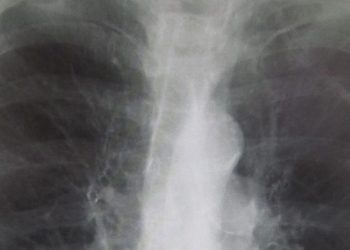Emergency department use of radiography in asthma increasing
Image: PD
1. Emergency Department (ED) use of radiography in asthma increased significantly between 1995 and 2009.
2. Pediatric-focused EDs have significantly lower rates of radiography use in children with asthma, bronchiolitis and croup.
Study Rundown: Nearly one million children in the U.S. present to the ED each year for asthma, bronchiolitis, or croup. Despite evidence that management of these conditions does not require diagnostic imaging, radiography is commonly used when children present with suggestive symptomatology. This study investigated the use of ED radiographs in children presenting with asthma, bronchiolitis, or croup. Results showed a significant increase in the use of radiography over the study period for ED visits related to moderate to severe asthma. In addition, they found that EDs with higher pediatric volumes were significantly less likely to obtain radiographs for all three conditions studied. This study was limited by unknown indications for the ordering of these radiographs and inclusion of radiography beyond chest and neck imaging. However, the national scope and detailed clinical data collection of this study allow its findings to strongly suggest a need for clearer ED guidelines regarding the need for radiographs for children with respiratory illnesses.
Click to read the study, published today in Pediatrics
Click to read an accompanying editorial published today in Pediatrics
Relevant Reading: Reduce the rads: a quality assurance project on reducing unnecessary chest X-rays in children with asthma
Study Author, Dr. Jane F. Knapp, MD, talks to 2 Minute Medicine: Department of Pediatrics, Children’s Mercy Hospitals and Clinics, University of Missouri-Kansas City School of Medicine, Associate Chair of Education, Medical Director of Graduate Medical Education, Professor of Pediatrics
“As a member of the Pediatric Subcommittee of the IOM Committee on the Future of Emergency Care, I learned that there was insufficient evidence regarding the quality of pediatric emergency care to support strong policy recommendations. That knowledge motivated our research.
We studied trends to explore how nimble the emergency care system was in translating research into practice. As it turned out, instead of the expected trend toward decreased use of radiographs for asthma, the rate increased. The trend for croup/bronchiolitis did not increase, but, based on evidence, no significant decrease in rate is disappointing performance. Although, we looked at pediatric EDs, it is important that the whole emergency care system be studied. To improve the quality of ED care for children significantly, the entire system must implement best practices and accountability for performance. Additionally, our study promotes the need for research-based guidelines that are specific regarding the use of radiographs.”
In-Depth [cross-sectional study]: Data was analyzed from 1995-2009 from the National Hospital Ambulatory Medical Care Survey (NHAMCS), a national survey designed to assess the use of emergency department and outpatient services by a random sampling of all visits. Asthma was studied in children 2 to 18 years old, bronchiolitis in children 3 months to 1 year old, and croup in children 3 months to 6 years old. Use of radiography was defined as completion of any x-ray study, including those done to examine regions other than the chest and neck. Moderate to severe asthma was defined by triage status and bronchodilator therapy. The use of radiographs for moderate to severe asthma increased by 2.4 fold during the years studied. Pediatric-focused EDs were significantly less likely to use radiography in all three conditions when compared to EDs without a pediatric focus (OR: asthma 0.44, bronchiolitis 0.37, croup 0.34).
By Laurel Wickberg and Leah H. Carr
More from this author: TV associated with higher BMI in teens, American Academy of Pediatrics updates its Medicaid Policy Statement, Children with infected family/classmates more likely to contract warts, Adjusted neonatal care coincides with decreased morbidity and mortality
© 2013 2minutemedicine.com. All rights reserved. No works may be reproduced without expressed written consent from 2minutemedicine.com. Disclaimer: We present factual information directly from peer reviewed medical journals. No post should be construed as medical advice and is not intended as such by the authors, editors, staff or by 2minutemedicine.com. PLEASE SEE A HEALTHCARE PROVIDER IN YOUR AREA IF YOU SEEK MEDICAL ADVICE OF ANY SORT.







